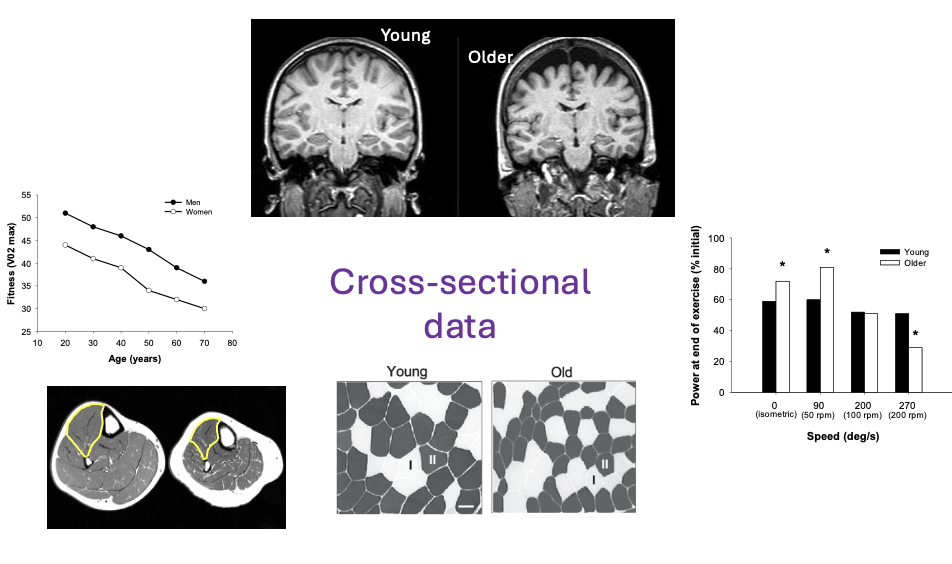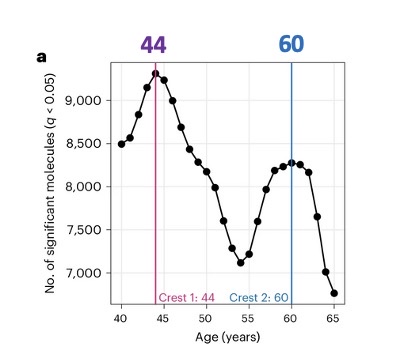Longitudinal studies of aging
1/10
There's no tags or description
Looks like no tags are added yet.
Name | Mastery | Learn | Test | Matching | Spaced |
|---|
No study sessions yet.
11 Terms
1.Define longitudinal study
2.Describe the general design (specific dates and numbers not necessary) and two main findings of each of the Framingham Heart Study and the Canadian Longitudinal Study on Aging
3.Describe the benefits and limitations of longitudinal studies on aging
Changes with Aging
cross sectional- not tracking a person over over time, they are diff groups of people of different ages

Cross-sectional data
cross sectional- not tracking a person over over time, they are diff groups of people of different ages

Longitudinal Studies of Aging
-so few of them because they take such a long time
-continuous of repeated measures to follow particular individuals over prolonged periods of times
Balitmore, winconsin, onatrio heart trial
Framingham Heart Study
•Started in 1948 to determine causes of Cardiovascular Disease
•Researchers & clinicians from Boston University- designed not as an aging but has become one- risk factors or causes of CV disease
•Longitudinal study of thousands of people
•Physical exams and lifestyle interviews (about health and lifestyle) every 2 years
Framingham Heart Study
1948- 5,209 men & women ages 30-62 enrolled
1971- Second generation of original participants enrolled-adding offspring of original participants (info across generations and family history)
Boston historically - Irish settlers city (e.g. Boston Celtics), 35 uni in the city
**predominantly white race, and participants coming from those universities who have time and resources to go, providing info for only a narrow group of individuals. roughly equal men and women
1994- Omni cohort enrolled- recruited omni cohort (meaning all)- not white and from universities- one of the first studies to do that
2002- Third generation of original participants enrolled- great grandchildren enrolled
MAIN GOAL
-coined the term risk factors
RISK FACTORS for heart disease and stroke
-smoking, inactivity, obesity, menopause *all initially came out of the Framingham Heart study
*were tracked until they died
•3101 participants (1652 offspring)
•more education was associated with a slower pace of biological aging and lower risk of death
•”interventions to promote educational attainment may slow the pace of biological aging to promote longevity”- educating ppl in the community can be benefical
-would not have known this if they stuck with their original cohort
*EDUCATIONAL SETTING provides you with opportunity to do PA, healthcare with university access- exposure to many opportunities are combining
*linked to biology not just subjective - telomeres get slower at a slower rate
*natural fit for studying the process of aging

Canadian Longitudinal Study on Aging
Participants: Recruited across 7 provinces from 2010-2015, with follow-ups
Tracking: 21,241 participants
•phone surveys
Comprehensive: 30,097 participants
•phone surveys + physical exams
Two groups
Canadian Longitudinal Study on Aging: Some major outcomes to date:
-new age normative values for functional fitness tests in Canadians AGED 45 TO 85 YEARS
-ratios of specific metabolites linked to aged-related diseases
senior fitness tests values were published in 1999
grip strength, walk time and set new normative values
*identified specific metabolites to diagnose or asses if they are more likely to develop cardiovascular disease, etc
Two times of accelerated aging
•108 participants
•25-75 years
•Tracked specific molecule functions for 1.7 years
two times where we have accelerated aging- function normally in a homeostatic mechanisms, at age 44 and age 60
-they will feel like they aged 5 years within that time span, within that year than any other time
•Two points of major disruption in molecules related to,
e.g.:
–Immune system
–Metabolism e.g. alcohol metabolism (cant handle things they could before, food, etc)

Benefits and limitations of longitudinal studies
Benefits:
-changes over time, rather than “snapshot”
-large cohorts (including offspring)
-less potential for bias in population
Limitations:
-associative- cant make ppl smoke in a study
-little/no control
-potential bias in population
*not experimental design- cant control extraneous factors